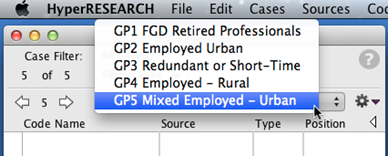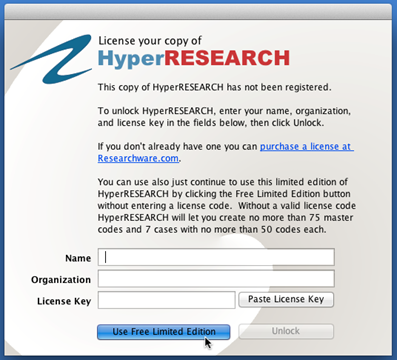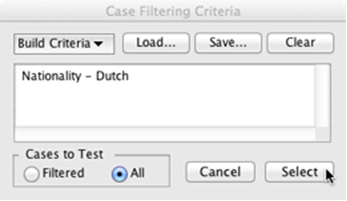

SMS messages, interaction in virtual environments, GPS data, or data from body sensors, for example, may be imported into DRS, synchronised with conventional recordings, and be replayed alongside them. Distinctively, DRS also enables these conventional forms of recording to be combined with ‘system logs’, which record interaction within computational environments or are the product of using computational techniques to analyse data.
#Hyperresearch coding free
Free and open source (no longer being developed or supported, but available to download)ĭRS enables the synchronisation, replay, and analysis of audio and video recordings.See our review of Delve (PDF) Digital Replay System (DRS)

Delve is developed by Alex Limpaecher and LaiYee Ho who are based in New York City, USA It enables the code-based analysis of text and was explicitly designed to support inductive approaches to qualitative analysis, driven by human interpretation. It builds on tools available in its predecessor, EthnoNotes developed by Lieber & Weisner during their time at UCLA.ĭelve is an online qualitative analysis platform, developed from a ‘human-centered’ design perspective to enable the collaborative analysis of qualitative data with tools that are simple to learn and navigate. Dedoose was developed by Eli Lieber and Thomas S Weisner at SocioCultural Research Consultants LLC. Tools for organising, coding and memo-ing and a range of qualitative, quantitative and mixed-methods visualisations. It includes tools for measuring inter-rater reliability, adjudicating identified differences between coders, and reporting on the accuracy of codes and coders over time.ĬAT was originally developed by Dr Stuart Shulman at the University of Pittsburgh, and QDAP-UMass at the University of Massachusetts Amherst. CAT was first released in 2007 and has been hosted and maintained by Texifter LLP.ĬAT was decomissioned in September 2020 but the code is open source, so available for others to host a version Dedooseĭedoose was designed to facilitate qualitative and mixed methods analysis and to support collaborative research. Coding Analysis Toolkit (CAT)ĬAT is a free and open source platform for the coding and annotating of text data in teams.
#Hyperresearch coding software
Originally developed by Thomas Muhr at the Technical University of Berlin, it is now developed by Scientific Software GmbH.ĪTLAS.ti Cloud was released in June 2018.ĪTLAS.ti version 9 was released in September 2020. & Mobile Aps for iPad and AndroidĪTLAS.ti provides tools for the qualitative analysis of textual, graphical, audio and video data, providing coding, memo-ing and query functionality along with sophisticated hyperlinking tools and semantic networking. A key function in the program is the ability to test and develop complex hypotheses about the data set by using the cased-based structure of the project and its coding.
#Hyperresearch coding code
The coding frame/book can be developed and modified and if required given a hierarchical structure and data coded at each code can be retrieved. It supports the use of a range of types of data, text, video, audio and images, which can be coded.

A key function in the program is the ability to test and develop complex hypotheses about the data set by using the cased-based structure of the project and its coding.ĪB - HyperRESEARCH is a computer program which can assist researchers with the qualitative analysis of their data.

N2 - HyperRESEARCH is a computer program which can assist researchers with the qualitative analysis of their data.


 0 kommentar(er)
0 kommentar(er)
